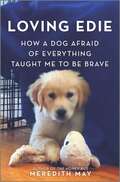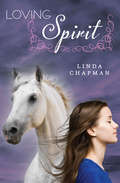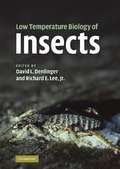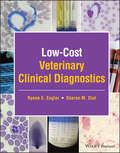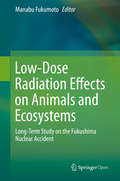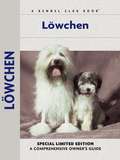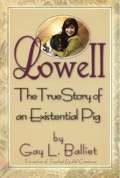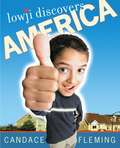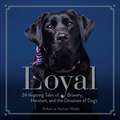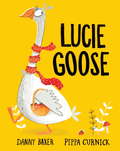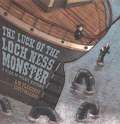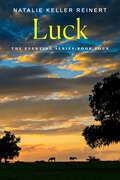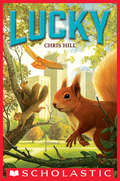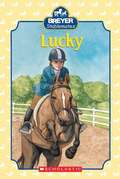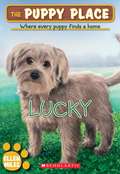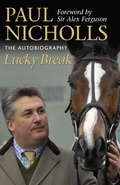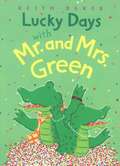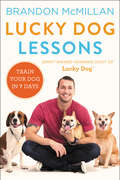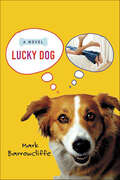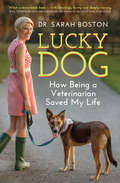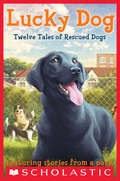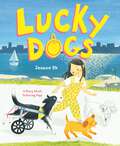- Table View
- List View
Loving Edie: How a Dog Afraid of Everything Taught Me to Be Brave
by Meredith MayFrom the author of The Honey Bus comes a wild and emotional memoir of family and self-discovery, featuring a lovable golden retriever named Edie Meredith May had a difficult childhood, with a mother who was physically present but emotionally absent. She learned early on to fend for herself, and never had to care for anyone else. When she and her wife, Jenn, adopt Edie, a sweet golden retriever puppy with saucer brown eyes and buttery white fur, Edie wins their hearts immediately. But it isn&’t long after Edie joins the family that the problems begin. Edie is an unusually anxious dog. She cowers around most people and the slightest noise sends her into a frenzy. Edie&’s fears become so intense that Meredith and Jenn can&’t leave the house. Is this normal puppy behavior or something more? Meredith grows determined to fix Edie, but what will she do if Edie can&’t be fixed? In this poignant and heartfelt memoir, Meredith shares her unforgettable journey with Edie, and the lessons about selflessness and unconditional love that she learns along the way. From treating Edie with CBD gummies to visiting a dog medium, Meredith shows just how far she is willing to go to save her dog. But maybe Edie is secretly the one doing the saving—if Meredith will only open her heart.
Loving Spirit (Loving Spirit #1)
by Linda ChapmanA young girl begins a new life in the English countryside and discovers a remarkable horseAfter her parents are killed in a car accident, Ellie leaves the rolling hills of New Zealand behind to live in England with her uncle, who is as cold and gray as the country she now must call home. A hard-eyed horse breeder, he hates weakness in all animals, whether they have four legs or two. Although Ellie loves horses, she can&’t stand being ordered around by her uncle and the coldhearted Luke. Even the kind words of her cousin Joe aren&’t enough to make her feel at home—until she meets a horse named Spirit. Ellie sees the skinny gray gelding at a sale, and spends the last of her insurance money to save his life. She can tell Spirit is special, but she has no idea that this horse will unlock a marvelous power in her. The two soon form a friendship the likes of which the world has never seen. Winner of the 2012 Lincolnshire Young People&’s Book Award.
Low Temperature Biology of Insects
by David L. Denlinger Richard E. Lee Jr.Low temperature is a major environmental constraint impacting the geographic distribution and seasonal activity patterns of insects. Written for academic researchers in environmental physiology and entomology, this book explores the physiological and molecular mechanisms that enable insects to cope with a cold environment and places these findings into an evolutionary and ecological context. An introductory chapter provides a primer on insect cold tolerance and subsequent chapters in the first section discuss the organismal, cellular and molecular responses that allow insects to survive in the cold despite their, at best, limited ability to regulate their own body temperature. The second section, highlighting the evolutionary and macrophysiological responses to low temperature, is especially relevant for understanding the impact of global climate change on insect systems. A final section translates the knowledge gained from the rest of the book into practical applications including cryopreservation and the augmentation of pest management strategies.
Low-Cost Veterinary Clinical Diagnostics
by Sharon M. Dial Ryane E. EnglarLow-Cost Veterinary Clinical Diagnostics A practical guide to maximizing the diagnostic value of in-house quick assessment tests (QATs) In Low-Cost Veterinary Clinical Diagnostics, the authors provide a hands-on resource designed to facilitate healthcare delivery across the spectrum of care. Historically, clinicians have been taught to apply the gold standard approach to the practice of medicine. However, recent advances in veterinary medical care and associated technologies have made practitioners question whether a one-size-fits-all approach is truly best. After all, when we perform diagnostic tests, are we testing out of the desire for completeness, to cover all bases for the good of the patient? Or are we testing because we are expected to? The reality is that gold standard care is not always advisable and not always possible. In clinical practice, veterinarians frequently encounter obstacles that limit their approaches to case management. Cost of care is a significant constraint that requires practitioners to rethink which diagnostic tests are essential. Not every patient requires a complete blood count (CBC), chemistry profile, urinalysis, and fecal analysis to obtain diagnostic value. This text suggests that the “best” approach to case management be determined by the situation, the context, the patient, and the client. While sophisticated panels of tests may remain the recommended approach to case management, Low-Cost Veterinary Clinical Diagnostics outlines entry-level, in-house diagnostic blood, urine, fecal, and body cavity fluid tests: how to perform them as well as the breadth and depth of patient-specific data that can be gleaned from quick assessment tests (QATs). Readers will also find: A thorough introduction to patient care considerations, communication strategies that facilitate cost-conscious shared decision-making Comprehensive explorations of quick assessment tests (QATs) in hematology, including packed cell volume (PCV), total solids (TS), buffy coat analysis, blood smears, blood glucose, blood urea nitrogen (BUN), saline agglutination tests, and activated clotting time. Practical discussions of quick assessment tests (QATs) involving urine, including urine color, dipstick analysis, specific gravity (USG), and urine sediment analysis Pragmatic evaluation of fecal analysis, including considerations surrounding fecal color, volume, consistency, and odor; saline smears or wet mounts, and fecal flotation. Discussion on body cavity fluid analysis Sample case vignettes, complete with question and answer (Q&A) Perfect for veterinary practitioners, veterinary technicians, veterinary and veterinary technician students, Low-Cost Veterinary Clinical Diagnostics offers a quick and easy reference guide to maximizing diagnostic value in those cases where care is cost-prohibitive.
Low-Dose Radiation Effects on Animals and Ecosystems: Long-Term Study on the Fukushima Nuclear Accident
by Manabu FukumotoThis open access book summarizes the latest scientific findings regarding the biological effects of the Fukushima Daiichi Nuclear Power Plant (FNPP) accident in 2011.Various cases of changes in animals and organisms have been reported since the FNPP accident. However, it is often unknown whether they are actually due to radiation, since the dose or dose-rate are not necessarily associated with the changes observed. This book brings together the works of radiation biologists and ecologists to provide reliable radioecology data and gives insight into future radioprotection.The book examines the environmental pollution and radiation exposure, and contains valuable data from abandoned livestock in the ex-evacuation zone and from wild animals including invertebrates and vertebrates, aqueous and terrestrial animals, and plants that are subjected to long-term exposure in the area still affected by radiation. It also analyzes dose evaluation, and offers new perspectives gained from the accident, as well as an overview for future studies to promote radioprotection of humans and the ecosystem.Since the biological impact of radiation is influenced by various factors, it is difficult to scientifically define the effects of low-dose/low-dose-rate radiation. However, the detailed research data presented can be combined with the latest scientific and technological advances, such as artificial intelligence, to provide new insights in the future.This book is a unique and valuable resource for researchers, professionals and anyone interested in the impact of exposure to radiation or contamination with radioactive materials.
Lowchen
by Carol Ann Johnson Juliette CunliffeGerman in name and French in origin, the Löwchen is an inquisitive, confident, charming "clown" with a happy temperament that endears him to all. Though small in size, the stylish Little Lion Dog, as he is called, is leonine in heart and appearance. The distinctive lion trim in which the coat is fashioned, with full mane and tufted tail, distinguishes him from his Bichon family relatives and makes him an impressive sight from city streets, parks and beaches to show rings. Effectively "saved from extinction" after World War II, the Löwchen dates back to the 15th century and today enjoys a following of ardent admirers who are dedicated to the breed's preservation. Written by world-renowned breeder/judge and author Juliette Cunliffe, this Special Limited Edition provides an insightful chapter on the breed's history in Europe, complemented by a special section by popular American dog author and Löwchen breeder Alice Bixler, who retells the breed's history and development in the United States. The book also details the breed's characteristics and discusses the breed standard. Further chapters discuss the selection of a breeder and puppy, preparing the home for the puppy's arrival, feeding, grooming and coat care, exercise and much more. The chapter detailing the house-training process and the basic obedience commands will be welcomed by any Löwchen owner, as will the sections about behavior and solving puppy problems. Additionally, a lavishly illustrated chapter on preventive healthcare by Dr. Lowell Ackerman provides up-to-date accurate information on inoculations, parasite control, selecting a veterinarian and other topics vital to the ownership of a healthy pure-bred dog.
Lowell
by Gay L. BallietOne day, while accompanying her husband Edgar on his veterinary rounds through the Pennsylvania countryside, Gay Balliet experiences love at first sight: a pot-bellied piglet. After she adopts Lowell, Gay is introduced to the refreshing, liberating and rebellious lifestyle of owning such a nontraditional pet.Together Gay and Lowell, with Gay's friend Susan, embark on a series of exciting adventures rescuing abandoned and abused porkers from uncaring owners, trips to the slaughterhouse and desperate plights. But it is when a frightening intruder threatens Gay's life and Lowell comes to her rescue that Gay learns Lowell has mastered the art of existential living and is a true hero of our time.
Lowji Discovers America
by Candace FlemingDear Jamshed, America is not so different from what we thought. I told you I wouldn't see a single cowboy riding across the plain, and I haven't. I have not even seen a plain. Still, there are some silver linings. They are: Trapper and King, the cat and dog who live in the apartment building. They are cuddly and waggy. I am not allowed to play with them, though, becayse they are supposed to catch mice and keep burglars away. Ironman. He owns a pig and talks to me a lot. But he is a grown-up. Kids. I can hear them playing outside. Too bad they do not want to play with me. I wish you were here. Do you wish I was in India? Write back soon. Your friend, Lowji
Loyal: 38 Inspiring Tales of Bravery, Heroism, and the Devotion of Dogs
by Rebecca Ascher-WalshThis treasury features heartwarming photographs and touching stories of dedicated working dogs who have gone above and beyond the call of duty and proven themselves as true heroes.This special collection of dog stories and photographs features four-legged heroes who have worked side by side with soldiers, searched the wreckage of natural and man-made disasters, changed families' lives through emotional support, and administered aid around the world and at home in the United States. Heart-warming photographs and touching anecdotes bring to life thirty-eight caring canines who have served the people who mean the most to them, from a German Shepherd who leads a blind man on his marathon training mssion to a belly rub-loving Sheltie who supports at-risk youth in the classroom. For anyone who has experienced the extraordinary affection of a dog, Loyal is a lasting celebration of the joys of canine companionship.
Lucie Goose
by Danny BakerA magnificently funny first picture book by Danny Baker, the popular comedy writer, journalist, radio DJ and screenwriter. Illustrated by rising star Pippa Curnick.Lucie Goose lives all alone in a house at the edge of the woods. She has never met or spoken to another animal of any sort until... a wolf, bear and lion turn up on her doorstep and go Rraaaarrrrrr! She should start screaming. She should run away. But Lucie Goose isn't very good at being scared. What will she do?Introducing a wonderfully charming and funny new picture book from two remarkable talents.
Luck of the Loch Ness Monster
by Alice Weaver Flaherty Scott MagoonOnce upon a time, on a long, slow trip to Scotland, a little girl named Katerina-Elizabeth tossed her oatmeal overboard-again, and again, and again. She was a picky eater, and oatmeal was her least favorite food.And once upon a time, a small worm, no bigger than a piece of thread, swam alongside an ocean liner bound for Scotland and ate bowl after bowl of tossed oatmeal. He had never tasted anything as wonderful as oatmeal in his whole life. A. W. Flaherty and Scott Magoon unravel the Loch Ness legend in this whimsical picture book for the picky (and not-so-picky) eater in all of us.
Luck: A Novel (The Eventing Series)
by Natalie Keller ReinertIn Natalie Keller Reinert’s utterly immersive and propulsive eight-book Eventing Series, we follow Jules and her friends through the joys and losses of competitive eventing as they climb to the top of their sport—and into one another’s lives and hearts. Jules and Pete have hit rock bottom. They are living in the middle of nowhere in a tiny horse trailer, dependent on nearby farms for training facilities. Despite all that, Jules has never been happier. She has her horses and her boyfriend and her loyal beagle, and, for perhaps the first time ever, she feels free. But Pete, who is still reeling from the loss of the beautiful farm he was supposed to inherit, struggles to adapt to their new life. And when word of their circumstances gets out, the owners Jules and Pete depend on begin to question whether they can trust them. Desperate to shore up their reputation, Jules starts teaching and is surprised that she enjoys it. As she begins to imagine a different kind of life, Pete schemes to get back to the top of the equestrian scene. When he resorts to questionable tactics to secure a new horse, Jules realizes how lost he is. Jules has never considered herself to be lucky, but maybe she’s had it wrong all along. Can she convince Pete that the only luck they need is their horses and each other?
Lucky
by Chris HillA classic animal adventure story featuring dueling squirrel clans, peace-keeping dogs, interspecies friendships, and unlikely heroes.Lucky, a lost little squirrel, finds himself in Albion Park surrounded by native squirrels that are very big, very tough, and VERY different than him. He needs lots of luck to fit in, and even more to pass the Squirrel Trial that will give him a permanent place in the park. But when he discovers a plot that threatens his new home, he'll need more than just good fortune to set things right.
Lucky (Breyer Stablemates)
by Jane E. GerverSpurred on by her older sister, Amy works hard to overcome her nervousness so that she and her horse Lucky can compete in their first horse show.
Lucky (The Puppy Place #15)
by Ellen MilesIt's going to take all of seven-year-old Charles's animal smarts to get this mixed-breed puppy, whom he finds after a storm, to trust him, and all the vet's training to save him. Will this Benji look-alike be lucky enough to survive and find a home? With strong dogs and helpful puppy tips included in every book, this playful series is not only fun to read but a great resource for prospective or current junior dog owners!
Lucky (The Puppy Place #15)
by Ellen MilesSeven-year-old Charles faces a super-sized challenge when torrential rain and an injured pup take his backyard camping trip by storm. It's going to take all of Charles's animal smarts to get this mixed-breed puppy to trust him and all the vet's training to save him. Will this Benji look-alike be lucky enough to survive and find a home? With strong dogs and helpful puppy tips included in every book, this playful series is not only fun to read but a great resource for prospective or current junior dog owners!
Lucky Break
by Paul NichollsThe revealing and honest autobiography of Britain's leading National Hunt trainer.Paul Nicholls is the former jockey who began training in 1991. Gradually he built up a reputation as one of the most astute and successful trainers in the business, with a special knack for getting it right on the big occasions. His depth of resources meant that on a unique occasion at Wincanton in January 2006, he became the first trainer ever to have six winners on a card. But it is for his role as the trainer of horses such as See More Business, Kauto Star and Denman, all of them Cheltenham Gold Cup winners, that he is best known.In this revealing and honest memoir, Champion Trainer Nicholls explains how he got to the top of his sport, and provides a fascinating insight into his methods and to the horses, jockeys and owners that have helped him achieve so much. Packed with insider stories that all race fans will love, and a foreword from Sir Alex Ferguson, this is without doubt the essential racing book for 2011.
Lucky Christmas
by Betsy DuffeyGeorge's father calls the kennel when Lucky attacks visiting great-aunt Octavia's sheepskin coat, and George tries valiantly to retrieve the playful puppy in time for Christmas.
Lucky Chuck
by Beverly ClearyVroom-vroom! Ratta-tatta,<P><P> ratta-tatta. Cha-kung! <P> Nobody can catch LUCKY CHUCK!<P> Speed along with Chuck in this reissue of a funny, fast-paced tale by one of America's most beloved authors, Beverly Cleary. You'll quickly learn what happens when safety rules are ignored.
Lucky Days with Mr. and Mrs. Green
by Keith BakerMr. and Mrs. Green return for another round of sweet and adventurous alligator escapades. This time they're trying their hand at detective work, entering a gumball-guessing contest, and--most daring of all!--participating in the town talent show. Happily for the Greens, luck is on their side. Luck and cookies--JUMBO cookies!
Lucky Dog Lessons: Train Your Dog in 7 Days
by Brandon McmillanThe celebrity dog trainer and Emmy-winning star of the CBS show Lucky Dog shares his training system to transform any dog--from spoiled purebred puppy to shelter-shocked rescue--into a model companion in just seven days.Each week on Lucky Dog, Brandon McMillan rescues an untrained, unwanted, "unadoptable" shelter dog. In the days that follow, these dogs undergo a miraculous transformation as they learn to trust McMillan, master his 7 Common Commands, and overcome their behavior problems--ultimately becoming well-mannered pets and even service dogs. With his labor of love complete, McMillan unites each dog with a forever family. Now, in his first book, McMillan shares the knowledge he has gained working with thousands of dogs of every breed and personality to help readers turn their own pets into well-trained Lucky Dog graduates. Lucky Dog Lessons begins with the basics--building trust, establishing focus and control, and mastering training techniques. From there, McMillan explains his playful, careful, and kind approach to training the 7 Common Commands he teaches every dog: SIT, STAY, DOWN, COME, OFF, HEEL, and NO. Next, McMillan provides solutions to common canine behavior problems, including house training issues, door dashing, chewing, barking, and common mealtime misbehaviors. Lucky Dog Lessons includes easy-to-follow steps, illustrative examples, tried-and-true tips and tricks, and photographs to demonstrate each technique. Throughout the book, McMillan shares inspiring stories about his favorite students and gives fans a behind-the-scenes look at the show and some of his most unique and challenging canine encounters, including some never-before-seen outtakes.Brandon McMillian believes that no dog is beyond saving, and the loving, positive, successful methods he offers will work wonders with even the most challenging dog. Create the happy pet family you want with Lucky Dog Lessons.
Lucky Dog: A Novel
by Mark BarrowcliffeDave Bartok is not having the best of years. His mother has just died, he is an addicted poker player, and (hugely in debt), his real estate business is sinking, and he doesn't really like his longtime girlfriend. When he gets saddled with an abandoned dog, he doesn't think things can get worse. And then Reg the dog starts talking --and only Dave can hear him.At first Dave thinks he's gone crazy, but he soon realizes he's found his soul mate. Dave and Reg start off on a madcap adventure that will find them tangled up with the mob, involved in an illegal real estate deal, cleaning up at the poker table, and stumbling toward true love.The wisdom of Reg the dog:On couches being chewable because they are actually sausages"It's got a skin, it's got stuffing, what am I not getting here?"On entering a dangerous establishment"Actually, I've changed my mind. There's no atmosphere so menacing it can't be banished by a ham sandwich."On Dave's awful girlfriend"She wants so to be pack leader. She acts as if she's in control when you're there, you defer to her all the time. Would it not be better if she were allowed to go and form her own pack?"On neckties"Every time you put it on you end up going somewhere you don't want to. That's what I call a leash."
Lucky Dog: How Being a Veterinarian Saved My Life
by Sarah BostonLucky Dog is a hilarious and heartwarming memoir by a renowned veterinary oncologist who tells us what we can learn about health care and ourselves from our most beloved pets.What happens when a veterinary surgical oncologist (laymen’s term: cancer surgery doctor) thinks she has cancer herself? Enter Sarah Boston: a vet who suspects a suspicious growth in her neck is thyroid cancer. From the moment she uses her husband’s portable ultrasound machine to investigate her lump — he’s a vet, too — it’s clear this will not be your typical cancer memoir.She takes us on a hysterical and thought-provoking journey through the human health care system from the perspective of an animal doctor. Weaving funny and poignant stories of dogs she’s treated along the way, this is an insightful memoir about what the human medical world can learn from the way we treat our canine counterparts. Lucky Dog teaches us to trust our instincts, be our own advocates, and laugh while we’re doing it.
Lucky Dog: Twelve Tales Of Rescued Dogs
by Elizabeth Cody Kimmel Marlane Kennedy Randi BarrowA collection of short stories from favorite authors, all about dogs and the kids who love them. Proceeds will be donated to RedRover, an organization that helps animals in need! This collection is full of heartwarming and hilarious stories about the Pawley Rescue Center, where rescued dogs find their way into hearts and homes. You'll meet Foxtrot, a feisty Pomeranian who can't bear the thought of leaving her best friend. And Beatrice, whose bark is definitely worse than her bite. And then there's Pumpkin, one of the 101 Chihuahuas who turn life at the center upside down. Whether drooling, dueling, or just fooling around, these captivating canines will show you why the dog is kid's best friend! LUCKY DOG features sweet and silly stories about playful pups and the kids who love them by some of your favorite authors: Randi Barrow, Marlane Kennedy, Elizabeth Cody Kimmel, Kirby Larson, C. Alexander London, Leslie Margolis, Jane B. Mason and Sarah Hines Stephens, Ellen Miles, Michael Northrop, Teddy Slater, Tui T. Sutherland, and Allan Woodrow.
Lucky Dogs: A Story About Fostering Pups
by Joowon OhFrom critically acclaimed author-illustrator Joowon Oh comes a poignant picture book about the special bonds between a girl and her foster dogs, with heartwarming messages of compassion, selflessness, and finding a home—in each other.One day, Ruth and her mom are in the park and see a pet adoption fair. Ruth is drawn to a cute little dog, but they are moving soon and can’t adopt. However, they can foster for a couple of months, and that’s how they wind up with Ginger. Then Daisy. Then Cody, a special-needs dog with injured hind legs. Can Ruth help Cody find his forever home?Lucky Dogs is a vibrant and charming story about three adorable dogs down on their luck and a girl with a big heart who wants to save them. Each hello is a delight as these furry friends teach our young heroine how to overcome her worries and be joyful, curious, and brave.
